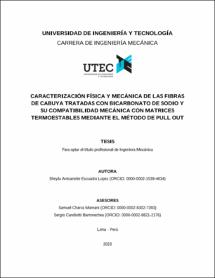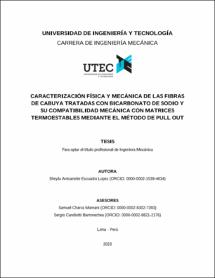Mostrar el registro sencillo del ítem
Caracterización física y mecánica de las fibras de cabuya tratadas con bicarbonato de sodio y su compatibilidad mecánica con matrices termoestables mediante el método de pull out
| dc.contributor.advisor | Charca Mamani, Samuel | |
| dc.contributor.advisor | Candiotti Barrenechea, Sergio Alonso | |
| dc.contributor.author | Escuadra Lopez, Sheyla Antoanette | |
| dc.date.accessioned | 2023-04-16T03:50:16Z | |
| dc.date.available | 2023-04-16T03:50:16Z | |
| dc.date.issued | 2023 | |
| dc.identifier.citation | Escuadra Lopez, S. A. (2023). Caracterización física y mecánica de las fibras de cabuya tratadas con bicarbonato de sodio y su compatibilidad mecánica con matrices termoestables mediante el método de pull out [Tesis de Título Profesional, Universidad de Ingeniería y Tecnología]. Repositorio Institucional UTEC. https://hdl.handle.net/20.500.12815/309 | es_PE |
| dc.identifier.uri | https://hdl.handle.net/20.500.12815/309 | |
| dc.description.abstract | Los materiales compuestos reforzados con fibras sintéticas generan problemas de contaminación ambiental, durante toda su vida útil, debido a que no son fácilmente reciclables, mucho menos son biodegradables. Por esta razón, las fibras naturales se han considerado como una alternativa ecológica; sin embargo, no pueden ser utilizadas como refuerzo en su estado natural debido a su compatibilidad con las matrices poliméricas. Para mejorar esta propiedad, las fibras son sometidas a tratamientos químicos tales como mercerización, salinización, entre otros; no obstante, estos tratamientos tienen un impacto negativo en el medio ambiente y en la salud de las personas. Por ello, el presente proyecto de tesis plantea el estudio de las propiedades físicas/mecánicas de la fibra de cabuya sometidas a un tratamiento utilizando bicarbonato de sodio, además de estudiar su compatibilidad interfacial con matrices termoestables para ser considerado como refuerzo de este tipo de matrices en material compuesto, de esta manera reducir la contaminación ambiental y otorgar un valor agregado a las fibras como materia prima. Inicialmente, se determinarán las propiedades mecánicas de las fibras a diferentes tiempos de tratamiento. La evaluación de las propiedades mecánicas de la interacción entre la fibra y matriz se realizará mediante el método experimental llamado prueba de desprendimiento por tensión y serán validadas utilizando la mecánica computacional. Como resultado, se obtuvo mejores propiedades mecánicas en las fibras tratadas por 7 días donde la resistencia, el módulo elástico y la deformación unitaria encontradas son de 744 MPa, 28.775 GPa y 0.037 mm/mm respectivamente. De igual modo, los resultados óptimos en la prueba interfacial fueron con las fibras mencionadas anteriormente embebidas en resina epóxica donde se obtuvo una resistencia interfacial de 6.30 MPa; además, se validó el modelo computacional con una diferencia menor al 5% en las propiedades mecánicas. | es_PE |
| dc.description.abstract | Composites reinforced with synthetic fibers generate environmental pollution problems throughout their useful life, because they are not easily recyclable, much less biodegradable. For this reason, natural fibers have been considered an ecological alternative; however, they cannot be used as reinforcement in their natural state due to their compatibility with polymer matrices. To improve this property, the fibers are subjected to chemical treatments such as mercerization, salinization, etc. However, these treatments have a negative impact on the environment and people’s health. For all the above, this thesis project proposes the study of the physical/mechanical properties of cabuya fiber subjected to a treatment using sodium bicarbonate, in addition to studying its interfacial compatibility with thermosetting matrices to be considered it as a reinforcement of this type of matrices in composite material, thus reducing pollution environmental and giving added value to fibers as raw material. Initially, the mechanical properties of the fibers will be determined at different treatment times. The evaluation of the mechanical properties of the interaction between the fiber and the matrix will be carried out with experimental method called pull out test and will be validated using computational mechanics. As a result, better mechanical properties were obtained in the fibers treated for 7 days where the stress, elastic modulus and strain found are 744 MPa, 28.775 GPa and 0.037 mm/mm respectively. Similarly, the optimal results in the interfacial test were with the previously mentioned fibers embedded in epoxy resin where an interfacial shear stress of 6.30 MPa was obtained; in addition, the computational model was validated with a difference of less than 5% in the mechanical properties. | es_PE |
| dc.description.uri | Tesis | es_PE |
| dc.format | application/pdf | es_PE |
| dc.language.iso | spa | es_PE |
| dc.publisher | Universidad de Ingeniería y Tecnología | es_PE |
| dc.rights | info:eu-repo/semantics/embargoedAccess | es_PE |
| dc.rights.uri | http://creativecommons.org/licenses/by-nc-nd/4.0/ | |
| dc.source | Repositorio Institucional UTEC | es_PE |
| dc.source | Universidad de Ingeniería y Tecnología - UTEC | es_PE |
| dc.subject | Fibras Naturales | es_PE |
| dc.subject | Propiedades mecánicas | es_PE |
| dc.subject | Propiedades químicas | es_PE |
| dc.subject | Comportamiento mecánico de los materiales | es_PE |
| dc.subject | Bicarbonato de sodio | es_PE |
| dc.subject | Natural fiber | es_PE |
| dc.subject | Mechanical properties | es_PE |
| dc.subject | Chemical properties | es_PE |
| dc.subject | Mechanical behavior of materials | es_PE |
| dc.subject | Sodium bicarbonate | es_PE |
| dc.title | Caracterización física y mecánica de las fibras de cabuya tratadas con bicarbonato de sodio y su compatibilidad mecánica con matrices termoestables mediante el método de pull out | es_PE |
| dc.title.alternative | Physical and mechanical characterization of cabuya fibers treated with sodium bicarbonate and their mechanical compatibility with thermosetting matrices by pull out method | es_PE |
| dc.type | info:eu-repo/semantics/bachelorThesis | es_PE |
| dc.subject.ocde | https://purl.org/pe-repo/ocde/ford#2.03.01 | es_PE |
| dc.publisher.country | PE | es_PE |
| thesis.degree.discipline | Ingeniería Mecánica | es_PE |
| thesis.degree.grantor | Universidad de Ingeniería y Tecnología. Ingeniería Mecánica | es_PE |
| thesis.degree.level | Título Profesional | es_PE |
| thesis.degree.name | Ingeniera Mecánica | es_PE |
| renati.advisor.dni | 24717255 | |
| renati.advisor.dni | 46084103 | |
| renati.advisor.orcid | https://orcid.org/0000-0002-8302-7393 | es_PE |
| renati.advisor.orcid | https://orcid.org/0000-0002-8821-2176 | es_PE |
| renati.author.dni | 72077656 | |
| renati.author.orcid | https://orcid.org/0000-0002-1539-4634 | es_PE |
| renati.discipline | 713046 | es_PE |
| renati.juror | Noel, Julien Georges Andre | |
| renati.juror | Bejarano Grández, Omar | |
| renati.juror | Flores Barreda, Carmen Elena | |
| renati.level | http://purl.org/pe-repo/renati/level#tituloProfesional | es_PE |
| renati.type | http://purl.org/pe-repo/renati/type#tesis | es_PE |
| dc.date.embargoEnd | 01/03/2024 | es_PE |
Ficheros en el ítem
Este ítem aparece en la(s) siguiente(s) colección(es)
-
Ingeniería Mecánica [73]






